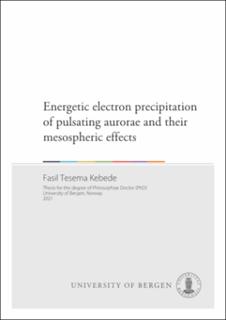Energetic electron precipitation of pulsating aurorae and their mesospheric effects
Doctoral thesis

Åpne
Permanent lenke
https://hdl.handle.net/11250/2758892Utgivelsesdato
2021-06-17Metadata
Vis full innførselSamlinger
Sammendrag
Pulsating aurorae (PsAs) are low-intensity diffuse type aurora, which switches on and off with a quasi-periodic oscillation period from a few seconds to ~ 10 seconds. They are predominantly observed after midnight magnetic local time, during the recovery phase of substorms, and at the equatorward boundary of the auroral oval. Pulsating aurorae are caused by precipitating energetic electrons, which span a wide range of energies between 10s of keV to 100s of keV electrons. The origin of PsA electrons is mainly from the plasma sheet and occasionally from the outer radiation belt. The stoppage altitude of these precipitating electrons can reach down to the mid-mesosphere (70km), a region where increased ionization can impact the ozone balance. The pulsating aurora altitude range consists of a transition between neutral dominating and plasma dominating regions. This makes the energy deposition associated with pulsating aurora very important in the magnetosphere-atmosphere-ionosphere dynamics.
To understand the contribution of the PsA electrons in ionizing the atmosphere and changing its chemistry, the energy of the electrons should be characterized. A general way of providing energy information about the precipitating electrons is constructing energy spectra from possible satellite and ground-based measurements. To investigate the atmospheric chemistry effects of PsA electrons, the spectra can be used as an input in atmospheric models. In addition, from the spatio-temporal characteristics of PsA a realistic input for the atmospheric models can also be constructed.
In this thesis, satellite measurements of precipitating electrons during PsA events identified using optical observations are used to construct the energy spectrum. The energy spectrum is used in a one-dimensional ion chemistry model to study the effects of the electrons in the middle atmosphere. Radar measurements of electron density and HF radio wave attenuation during PsA are used to characterize the ionization level and the spatio-temporal extent of PsA. The ionization level of different types of PsA is also studied using electron density measurements and ion chemistry model outputs.
Består av
Paper I: Tesema, F., Partamies, N., Tyssøy, H. N., Kero, A., & Smith-Johnsen, C.: Observations of electron precipitation during pulsating aurora and its chemical impact. Journal of Geophysical Research: Space Physics, 125, e2019JA027713. https://doi.org/10.1029/2019JA027713, 2020. The article is available at: https://hdl.handle.net/11250/2740098Paper II: Tesema, F., Partamies, N., Nesse Tyssøy, H., and McKay, D.: Observations of precipitation energies during different types of pulsating aurora, Annales Geophysicae, 38, 1191–1202, https://doi.org/10.5194/angeo-38-1191-2020, 2020. The article is available at: https://hdl.handle.net/11250/2756880
Paper III: Bland, E., Tesema, F., and Partamies, N.: D-region impact area of energetic electron precipitation during pulsating aurora, Annales Geophysicae, 39, 135–149, https://doi.org/10.5194/angeo-39-135-2021, 2021. The article is available in the thesis file.
Paper IV: Tesema, F., Partamies N., Whiter D. K., Ogawa, Y., Types of pulsating aurora: Comparison of model and EISCAT electron density observations, submitted to Annales Geophysicae, March 2021. The article is available in the thesis file.